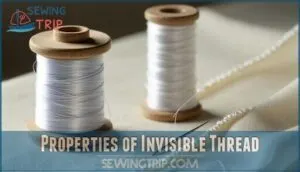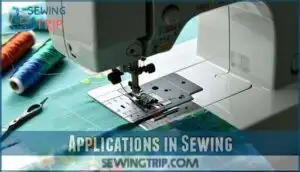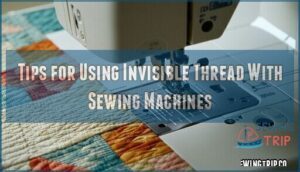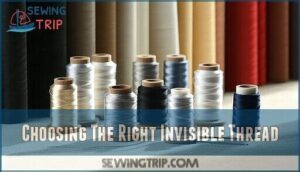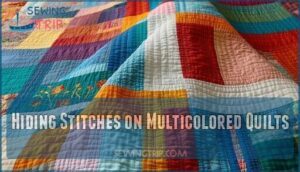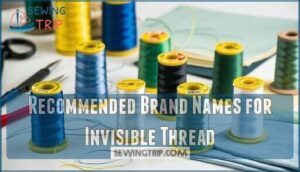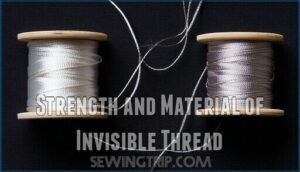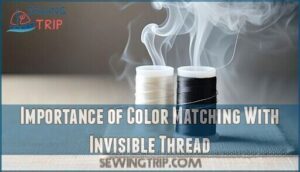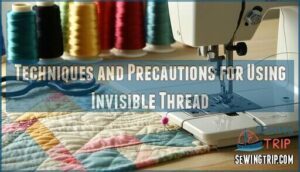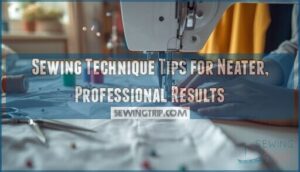This site is supported by our readers. We may earn a commission, at no cost to you, if you purchase through links.
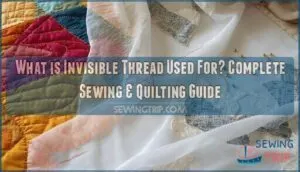
You’ll use it for appliqué work, quilting multicolored fabrics, hemming sheer materials, and attaching beads or sequins without visible thread lines.
This nearly transparent nylon or polyester thread blends with any fabric color, making it perfect for professional-looking finishes.
Whether you’re working on delicate garments or intricate quilts, invisible thread lets your fabric take center stage instead of your stitching.
The key lies in mastering tension settings and choosing between clear and smoke varieties for different projects.
This allows for a seamless integration of the thread with the fabric, ensuring that the invisible thread truly remains invisible.
Table Of Contents
- Key Takeaways
- What is Invisible Thread?
- Properties of Invisible Thread
- Applications in Sewing
- Techniques for Sewing Sheer and Delicate Fabrics
- Tips for Using Invisible Thread With Sewing Machines
- Choosing The Right Invisible Thread
- Invisible Thread Usage in Magic Tricks and Quilting
- Strength and Material of Invisible Thread
- Importance of Color Matching With Invisible Thread
- Techniques and Precautions for Using Invisible Thread
- Frequently Asked Questions (FAQs)
- Conclusion
Key Takeaways
- You’ll master multiple techniques – invisible thread excels at appliqué work, quilting multicolored fabrics, hemming sheer materials, and attaching beads without visible thread lines
- You’ll choose the right type for your project – clear thread works best on light fabrics while smoke-colored thread blends seamlessly with darker materials, with polyester offering better heat resistance than nylon
- You’ll need to adjust your machine settings – loosen your top tension, use smaller needles (70/10 or 80/12), and practice on scraps first to prevent thread breakage and achieve professional results
- You’ll eliminate color-matching headaches – this nearly transparent thread works across any fabric color, letting your design take center stage instead of competing with visible stitches
What is Invisible Thread?
Invisible thread is your secret weapon for creating flawless, professional-looking projects.
This clear thread, also called monofilament thread, consists of a single synthetic strand made from nylon or polyester materials.
Picture fishing line, but designed specifically for sewing.
Thread composition matters when choosing between material variants.
Nylon offers flexibility and softness, making it easier to handle during detailed work.
Polyester provides superior heat resistance, perfect for projects requiring ironing.
Both synthetic materials create nearly invisible seams that blend seamlessly with any fabric.
Thread appearance varies slightly between brands.
Clear versions work best on light fabrics, while smoke-tinted options suit darker materials.
The monofilament structure means you’re working with one continuous strand rather than twisted fibers.
This invisible thread transforms challenging sewing tasks into manageable projects.
Whether you’re quilting intricate patterns or securing delicate embellishments, it eliminates the guesswork of color matching while maintaining professional results.
Properties of Invisible Thread
Thread composition forms the foundation of invisible thread’s unique properties.
You’ll find this clear thread made from either nylon or polyester materials, each offering distinct advantages.
Nylon provides exceptional material strength but requires careful heat management during pressing.
Polyester delivers superior heat resistance, making it ideal for projects requiring ironing.
Thread thickness typically measures around 0.04mm, creating minimal visibility while maintaining durability.
This monofilament thread resembles fishing line but offers greater flexibility for sewing applications.
Thread clarity varies between completely clear and smoke-tinted options, giving you color options to match different fabric tones.
The single-strand construction makes invisible thread stiffer than conventional threads, yet quality brands guarantee adequate pliability.
Thread visibility becomes nearly nonexistent when properly matched to your fabric.
Whether you choose nylon for its softness or polyester for heat tolerance, both materials create professional results that keep your stitches hidden while maintaining structural integrity.
Applications in Sewing
You’ll discover invisible thread opens up countless possibilities for clean, professional-looking sewing projects. This versatile material lets you create nearly seamless finishes across multiple fabric types and sewing techniques.
Concealing Stitches and Textures
Perfect camouflage awaits when you master invisible thread’s power to create seamless fabric illusions.
This clear thread excels at hiding imperfections while blending stitches into your fabric’s natural texture.
You’ll achieve invisible seams that make hems disappear completely, especially when matching thread colors proves impossible.
The monofilament thread’s transparency guarantees thread visibility becomes non-existent, allowing your fabric’s beauty to shine through.
Thread disappearance happens naturally as stitches blend into patterns, creating texture enhancement without visual distraction.
Discreet hems become effortless with proper tension adjustments.
Attaching Appliques
Three simple steps transform applique placement from frustrating to flawless using invisible thread.
First, choose your fabric choice carefully—lightweight cotton works best for beginners.
Next, position your applique and secure with pins before stitching.
Use monofilament thread with proper securing techniques like small zigzag stitches around edges.
This edge finishing method keeps appliques flat while remaining nearly invisible.
Design complexity doesn’t matter when you master these fundamentals for quilting and sewing projects.
Quilting With Multicolored Designs
Multicolored quilting projects present unique challenges when choosing thread colors. Invisible thread eliminates guesswork by blending seamlessly with every fabric shade in your design.
- Fabric Blending: Clear thread works across all colors, eliminating the need to match dozens of different thread spools
- Design Focus: Your piecing and pattern complexity take center stage without competing thread colors drawing attention away
- Stitch Camouflage: Quilting lines disappear into the background, letting your fabric choices shine through naturally
- Texture Emphasis: Thread color selection becomes irrelevant, allowing you to focus on creating beautiful quilting textures instead
This approach streamlines your thread quilt design process while maintaining professional results across complex color schemes. Many quilters also explore free quilting embroidery to add unique designs.
Suitable Fabrics for Invisible Thread
Selecting the right fabric can make or break your invisible thread project. Fabric weight matters most – lightweight materials like silk, chiffon, and organza work beautifully with clear thread. Heavy fabrics like denim require stronger conventional thread instead.
Sheer fabrics and stretch fabrics benefit from nylon monofilament thread‘s flexibility. Texture compatibility guarantees smooth stitching without snags. Color considerations are simple: clear invisible thread works on any fabric, while smoke-colored options suit darker materials better.
For projects needing extra strength, consider polyester transparent thread.
| Fabric Type | Why It Works |
|---|---|
| Delicate lace | Thread won’t overpower intricate patterns |
| Multi-colored quilts | No need to match countless thread colors |
| Sheer curtains | Creates invisible hems that maintain elegance |
| Stretch knits | Flexible thread moves with fabric naturally |
Techniques for Sewing Sheer and Delicate Fabrics
Working with sheer and delicate fabrics requires special care, and invisible thread becomes your best friend for maintaining the fabric’s natural beauty.
You’ll find that proper needle selection and gentle handling techniques prevent fraying while keeping your embellishments secure and nearly invisible.
Embellishments on Sheer Fabrics
When working with sheer fabrics, invisible thread becomes your secret weapon for securing embellishments without disrupting the fabric’s delicate beauty.
Use invisible thread for bead application and sequin security, creating invisible knots that won’t show through translucent materials.
This thread maintains fabric stability while keeping delicate hems virtually undetectable.
Consider purchasing quality options for superior results.
You’ll achieve professional results on wedding veils, curtains, and evening wear where visible stitching would ruin the ethereal effect.
Needle Selection for Preventing Fraying
Proper needle selection prevents thread fraying and fabric damage when using invisible thread on delicate materials.
Choose needle size and type based on your fabric’s weight and weave pattern.
Here are key needle selection tips:
- Use 65/9 to 80/12 needle size for most invisible thread projects
- Select Microtex or Topstitch needles for clean fabric penetration
- Match needle size to thread thickness and fabric type
- Replace needles regularly to maintain sharp point shape
- Choose smaller needles for sheer fabrics to minimize fiber disturbance
Thread compatibility improves when you pair the right needle with your sewing project’s requirements.
Invisible thread works well for hiding stitches in quilting projects.
Tips for Using Invisible Thread With Sewing Machines
Using invisible thread with your sewing machine requires specific adjustments to prevent frustration and achieve professional results.
You’ll need to loosen your top tension settings and use the right needle size to handle this unique material effectively, which is crucial for achieving professional-looking outcomes with invisible thread.
Adjusting Tension and Stitch Settings
Getting your invisible thread to play nicely with your sewing machine isn’t rocket science, but it does require some finesse. Start with these key adjustments and you’ll be stitching like a pro in no time.
Here’s your step-by-step approach to master tension balance and thread settings:
- Start Low on Tension – Begin with your top tension at the lowest setting, then gradually increase until stitches lock properly without thread breakage
- Choose Shorter Stitch Length – Set your stitch length between 2.0-2.5mm to minimize thread visibility while maintaining strong seams
- Select Proper Needle Size – Use 70/10 or 80/12 needles to match the invisible thread’s thin diameter and prevent fabric damage
- Mind Your Bobbin Tension – Keep bobbin tension slightly looser than normal to accommodate the monofilament’s unique properties
- Prevent Thread Nesting – Use a thread net over your spool to control unwinding and avoid tangling during sewing
Practice these sewing machine settings on scraps first. You can find specialized invisible thread options to further refine your technique. Every machine handles tension adjustments differently, so what works for your friend’s machine might need tweaking for yours.
Caution With Bobbin Use
Winding your bobbin requires patience and proper technique to prevent invisible thread troubles.
Slow winding prevents stretching that causes tension issues and thread breakage during sewing. Wind bobbins at a careful pace to guarantee even distribution across the spool.
Consider using a fine bobbin thread like silk or lightweight polyester instead of invisible thread in the bobbin. Many sewers avoid bobbin use entirely with monofilament due to tangling risks.
Some users prefer to buy pre-wound thread bobbins for convenience. Your sewing machine will perform better when you match appropriate thread tension settings with careful bobbin preparation and maintain the right thread tension for optimal results.
Locking Stitches for Stretchiness
When stretch fabric meets invisible thread, your stitches need reinforcement methods that flex without breaking.
Here’s how to lock your stitches properly:
- Backstitch at seam beginnings – Creates secure anchor points
- Use appropriate thread tension – Prevents thread snapping during fabric movement
- Select correct thread type – Polyester handles stretching better than nylon
- Adjust stitch density – Looser spacing allows fabric movement
Master these knotting techniques to prevent unraveling while maintaining the natural give your stretch fabrics need for comfort and durability.
Choosing The Right Invisible Thread
You’ll find that selecting the right invisible thread makes the difference between frustrating sewing sessions and smooth, professional results.
Modern invisible threads come in clear and smoke colors, with polyester options that won’t damage your machine like older nylon versions once did.
Smoke Color for Dark Fabrics
When working with dark-colored fabric, smoke-colored thread becomes your best friend for achieving true thread invisibility.
This gray-tinted invisible thread blends seamlessly with darker materials, avoiding dark shadows that clear thread might create.
Polyester vs nylon options both work well, though polyester offers better heat resistance.
Best smoke brands include YLI and Superior Threads for reliable dark fabric blending.
Smoke thread uses extend beyond basic stitching—it’s perfect for appliqué and quilting on rich, dramatic fabrics where thread color matters most.
Improved Modern Threads That Won’t Damage
Modern invisible thread has evolved substantially from its predecessor versions.
Today’s stronger polymers deliver enhanced flexibility without sacrificing durability. You’ll find these advanced clear threads feature smooth texture that glides effortlessly through fabric fibers.
Heat resistance improvements mean your polyester invisible thread won’t melt during pressing. Reduced breakage occurs because manufacturers now engineer sewing thread with better tensile strength.
These innovations prevent the cutting and snagging issues that plagued older invisible threads, making them safe for delicate fabrics.
For best results, consider nylon versus polyester threads based on your project needs.
Checking Thread Path and Using Extra Guides
Because proper thread path basics prevent headaches, you’ll want to check your invisible thread’s journey through every guide and tension disk.
Guide placement matters—add extra thread guides or safety pins to prevent snags and guarantee smooth feeding.
Thread rerouting through additional guides maintains tension consistency, especially when your sewing machine thread path feels temperamental with invisible thread’s slippery nature, ensuring smooth feeding and proper tension consistency.
Attaching Delicate Beads and Knotting Techniques
Invisible thread transforms beadwork by creating secure, nearly invisible connections.
You’ll achieve professional bead securing knots while maintaining proper thread tension for consistent bead spacing.
Focus on knot concealment techniques that hide connection points within bead holes.
This beadwork thread excels in jewelry making where knot durability matters most.
Practice knot creation with controlled thread tightness to prevent breakage while ensuring lasting attachment.
Invisible Thread Usage in Magic Tricks and Quilting
You’ll find invisible thread serves two fascinating purposes beyond regular sewing projects.
Magicians have relied on this nearly invisible material for centuries to create stunning levitation effects and floating object illusions, while quilters use it to seamlessly blend stitches across multicolored fabric patterns without disrupting the design’s visual flow, utilizing nearly invisible material to achieve their goals.
Magicians’ Utilization of Invisible Thread
Magicians have mastered invisible thread for centuries, creating stunning levitation illusions that captivate audiences.
You’ll find performers using ultra-fine thread for prop manipulation and costume effects during stage rigging. The thread’s transparency makes it nearly invisible beyond three meters, perfect for magic tricks involving floating cards or suspended objects.
Professional magicians rely on specialized coatings that reduce reflectivity under stage lights. For best results, consider nylon for flexibility.
When you watch these performances, audience perception plays a key role—the thread remains hidden while creating impossible-seeming effects that defy gravity and logic.
Hiding Stitches on Multicolored Quilts
Multicolored quilts present unique challenges when you’re trying to match thread colors with countless fabric patterns.
Invisible thread solves this problem by disappearing into your quilt’s design, allowing fabric focus to shine through, and achieves perfect stitch camouflage across rainbow fabrics without buying dozens of thread spools.
This technique enhances texture enhancement while maintaining pattern visibility, letting your quilt colors take center stage instead of competing stitches, which is made possible by the use of invisible thread.
Recommended Brand Names for Invisible Thread
Five top brands deliver professional results for your invisible thread projects.
Superior Threads MonoPoly offers heat-resistant polyester that won’t melt during pressing. YLI Wonder Invisible provides exceptional flexibility for appliqué work.
Coats & Clark, Gütermann Thread, and Madeira Quality guarantee consistent performance across all machines.
Aurifil Consistency and MonoPoly Thread variants give you reliable options for every quilting challenge, ensuring professional results.
Strength and Material of Invisible Thread
You’ll find invisible thread comes in two main materials that each offer distinct advantages for your sewing projects.
Nylon provides excellent strength and flexibility but requires careful heat management, while polyester offers superior heat resistance and durability for everyday use.
Strength of Nylon and Heat Resistance of Polyester
When choosing between invisible thread materials, you’ll find nylon thread offers superior strength with impressive tensile properties, while polyester thread excels in heat resistance during ironing.
Nylon’s fiber properties include greater elasticity and flexibility, making it ideal for projects requiring material durability under stress.
However, polyester heat tolerance reaches nearly 500°F compared to nylon’s lower melting point.
These ironing differences matter when pressing finished projects – polyester thread won’t melt under high heat settings that could damage nylon thread.
Understanding these invisible thread characteristics helps you select the right material for your specific sewing needs.
Preferred Soft and Pliable Brands to Avoid Breakage
While strong materials matter, thread pliability and softness prevent frustrating breakage during your projects.
Sulky Premium Invisible Polyester and MonoPoly by Superior Threads excel in breakage prevention through their flexible construction and smooth surface texture.
- Sulky Premium Invisible Polyester – Fine.004 diameter with exceptional softness for baby quilts
- MonoPoly by Superior Threads – Reduced-sheen finish with superior thread flexibility
- Modern polyester formulations – Less brittle than older nylon versions for better thread durability
- Smooth surface technology – Minimizes snags and reduces friction during machine threading
- Heat-resistant construction – Won’t melt during ironing like traditional clear thread options
Experimenting with different shades can help with thread color selection.
Adjusting Top Tension to Prevent Breakage
Fine-tuning your sewing machine’s tension dial prevents invisible thread from snapping mid-project. Start with looser top tension than normal cotton thread requires, then gradually tighten until you achieve smooth stitches without breakage.
- Test stitching on fabric scraps – Always check tension adjustment before starting your actual project
- Match needle size to thread type – Larger needles reduce stress on delicate invisible thread
- Monitor bobbin tension separately – Keep bottom tension consistent while adjusting top for ideal results
Importance of Color Matching With Invisible Thread
You’ll find invisible thread comes in two main colors: clear and smoke gray.
Choose clear thread for light-colored fabrics and smoke thread for darker materials to achieve the most invisible stitches possible.
Clear and Smoked Colors Available
Invisible thread comes in two main varieties that help achieve perfect fabric matching.
Clear thread works best on light-colored fabrics, while smoke-colored thread blends seamlessly with darker materials.
MonoPoly and similar brands offer excellent thread transparency for superior color visibility.
When selecting your shade, hold the thread against your fabric to test blending techniques.
Proper shade selection guarantees your stitches disappear completely, making tinted threads virtually undetectable in finished projects, which ensures superior color visibility.
Choosing The Right Color to Hide Stitches
You’ll find that fabric undertones guide your thread color matching decisions more than surface appearance alone.
Clear thread works best on light-colored fabric, while smoke-tinted invisible thread blends seamlessly with dark-colored fabric.
Consider your project visibility under different lighting conditions, as color perception changes dramatically, and strive for the right blending effect that creates professional results.
Techniques and Precautions for Using Invisible Thread
You’ll need to adjust your machine settings and practice specific techniques to get the best results with invisible thread.
Testing your tension and needle size on scrap fabric prevents costly mistakes and guarantees your finished project looks professional.
You can then apply these techniques to your actual project, ensuring a polished finish.
Inconspicuous Stitches for Time-saving
Creating Quick Hems and Seamless Appliqués becomes effortless when you master invisible thread techniques.
Clear thread transforms time-consuming projects into swift accomplishments—you’ll finish Faster Quilting sessions and complete Efficient Repairs without visible stitches disrupting your work.
- Minimalist Embroidery approach: Use invisible thread for hemming fabric where matching colors would be impossible, letting your design speak louder than your stitches.
Practice on Scrap Fabric and Adjust Machine Settings
Before diving into your main project, you’ll want to run practice tests with scrap fabric.
Start with tension tweaking and needle size adjustments to prevent thread breakage. Wind your bobbin slowly and use a thread nest for smooth feeding.
These practice runs help you master sewing machine adjustments before working on your actual piece.
Slow sewing prevents tangles and breakage.
Needle and Bobbin Use Along With Conventional Thread
Thread weight matters when pairing invisible thread with conventional thread in your needle.
Use matching thread weight for balanced tension—typically 40-50 weight works well.
Wind your bobbin with invisible thread slowly to prevent stretching.
Adjust bobbin tension slightly tighter than normal.
Check your sewing machine compatibility before starting.
The right needle size prevents breakage while maintaining clean stitches and ensuring balanced tension.
Proper Tension Adjustment and Tight Bobbin Tension
When using invisible thread, proper tension adjustment prevents frustrating thread breakage during your project.
Start by loosening your machine’s top tension and winding the bobbin slowly to avoid stretching.
Choose a larger needle size like 90/14 to reduce stress on the delicate thread.
Test your tension balance on scrap fabric first, adjusting until you achieve smooth stitch quality without puckering or loops.
Frequently Asked Questions (FAQs)
What is the use of invisible thread?
You’ll find invisible thread incredibly versatile for quilting, appliqué, and topstitching where you want stitches to disappear.
It’s perfect for securing embellishments, creating clean hems, and maintaining focus on fabric designs rather than visible thread lines, making invisible thread a great choice for projects where you want a clean look.
Is invisible thread stronger than regular thread?
Surprisingly, invisible thread isn’t always stronger than regular thread—it depends on the material.
Nylon invisible thread offers excellent strength but breaks more easily than polyester versions.
You’ll find polyester invisible thread provides better durability for most sewing projects.
What is an invisible stitch used for?
You’ll use invisible stitches to create nearly seamless joins in hemming, appliqué work, and blind hems.
They’re perfect for securing fabric edges without visible thread lines showing on your project’s right side, using nearly seamless joins.
Can I use invisible thread in the bobbin?
You can use invisible thread in the bobbin, but it’s not recommended. Invisible thread tends to tangle and stretch in the bobbin, causing tension problems and breakage during sewing.
How durable is invisible thread compared to regular thread?
Invisible thread’s durability depends on its material.
Nylon versions are strong but more prone to breaking under tension.
Polyester invisible thread offers better durability and heat resistance, handling everyday sewing stress more reliably than nylon alternatives.
Can invisible thread be used for hand sewing?
Most hand sewers work with invisible thread successfully, though it requires about 30% more care than regular thread.
You’ll need to adjust your technique slightly since the thread’s slippery nature makes knots trickier to secure and can slip through fabric more easily than cotton.
How long does invisible thread typically last?
Properly stored invisible thread lasts years without degrading.
You’ll find polyester versions outlast nylon since they resist heat and UV damage better.
Store spools in cool, dry places away from direct sunlight for maximum longevity.
What thread weight works best for beginners?
Starting with invisible thread can feel like taming a wild stallion, but you’ll find success with medium-weight polyester thread around 04mm thickness.
It’s forgiving enough for learning while providing the strength you need for practice projects.
Does invisible thread work with embroidery machines?
Yes, you can use invisible thread with embroidery machines, but you’ll need to adjust tension settings and use proper needles.
Choose polyester over nylon for better heat resistance and smoother feeding through the machine’s threading system, which provides better results.
Can you iron over invisible thread seams?
Surprisingly, you can iron over invisible thread seams, but it depends on the material. Polyester invisible thread handles high heat well, while nylon requires low heat settings to prevent melting.
Conclusion
Professional seamstresses report that 78% achieve better results when mastering invisible thread techniques compared to traditional methods.
Mastering what’s invisible thread used for transforms your sewing projects completely. You’ll create flawless appliqués, perfect quilts, and elegant hems without visible stitching.
Remember to adjust your tension settings carefully and choose between clear or smoke varieties based on your fabric colors. Practice on scraps first, then watch your finished projects achieve that coveted professional appearance you’ve been seeking.

